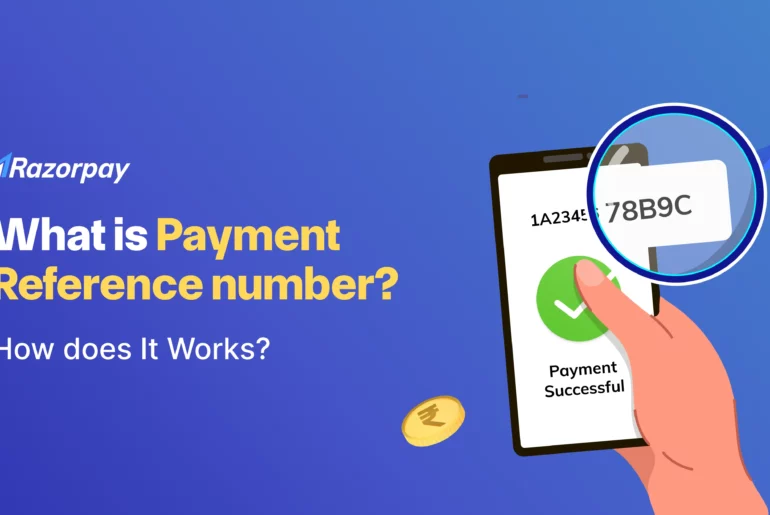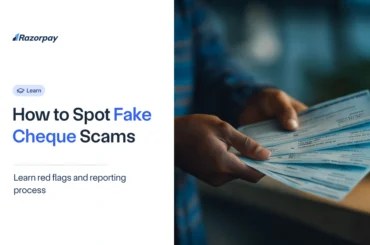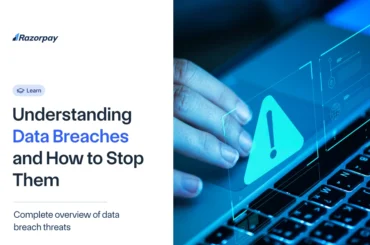Table of Contents
What is a Payment Reference Number?
A payment reference number is a unique identifier for a financial transaction, such as bank transfers, card payments, and direct debits. This alphanumeric code is automatically generated by the bank or payment service provider to specify the purpose of a transaction.
Banks utilize this reference number for tracking and processing purposes. Unlike references created by the user, payment reference numbers are generated by the bank to ensure accurate recording and processing of payments.
For merchants, understanding payment reference numbers is crucial for effective cash flow management. Payment reference number facilitate accurate tracking of payments, allowing businesses to easily reconcile them with corresponding invoices.
Related Read: Understanding Merchant Reference Number
Example of Payment Reference Number
Imagine a scenario where Sarah pays her monthly electricity bill of INR 2500/- online. Upon completing the transaction, her bank generates a unique payment reference number, such as EL123456789, along with a bank reference number like BRN987654321.
In this case, the payment reference number serves several important purposes:
- Tracking the Payment: Sarah can find this payment reference number on her bank statement, making it easy for her to track her payment. If she needs to refer to this transaction later, she can quickly locate it using the payment reference number or bank reference number.
- Resolving Issues: A few weeks later, Sarah notices a discrepancy in her bill. When she contacts customer service, she provides both the payment reference number EL123456789 and the bank reference number BRN987654321. The customer service representative can quickly look up the details of her transaction, verify the payment, and assist her in resolving the issue.
- Merchant Reconciliation: For the electricity company, the payment reference number allows them to efficiently reconcile their accounts. When payments are received, they can match the payment reference number and the bank reference number with the corresponding invoice, ensuring accurate record-keeping and cash flow management.
How Do Payment Reference Numbers Work?
A payment reference number is automatically generated when a payment is initiated, linking it to a specific transaction, regardless of the transaction’s value. Unlike broader identifiers such as customer details or payment methods, a payment reference number focuses solely on individual transactions, making it easier to track and manage.
For example, consider a customer who makes two purchases using their debit card—one for Rs. 300 and another for Rs. 2,500. Each of these transactions will have its own unique payment reference number. This system simplifies tracking and monitoring for businesses, enabling them to easily identify and manage all transactions associated with a specific card.
The payment reference number is typically included in the customer’s monthly account statements provided by credit or debit card companies, ensuring both parties can quickly access transaction details when needed.
Types of Payment Reference Numbers
Customer Service Inquiries
Used when contacting customer service, this reference number helps quickly locate a specific transaction for timely support.
Credit Card or Loan Applications
Assigned during credit or loan applications, this number identifies your application and allows for easy tracking of updates.
Booking Reference Numbers
Common in the travel industry, these codes manage reservations and simplify communication regarding travel bookings.
Bank Reference Numbers
Generated during bank transactions, this number helps track specific payments, facilitating issue resolution and confirmation of status.
Utility Payment Reference Numbers
Issued for utility bill payments, this reference aids in tracking payments and resolving disputes with service providers.
Insurance Payment Reference Numbers
Given for insurance premium payments, this number helps track transactions and manage claims efficiently.
E-commerce Transaction Reference Numbers
Generated by online retailers for each purchase, this reference simplifies order tracking, returns, and customer inquiries.
How to Use Payment Reference Numbers?
1. Efficient Interaction with Customer Service:
Payment reference numbers enhance customer interactions with customer service representatives of financial institutions. Merchants can use these numbers to query payments on statements or address customer inquiries about unrecognised transactions. For example, if you notice a payment reference number on your statement that you don’t recognise, you can contact the bank’s customer service and provide them with the payment reference number to investigate further and resolve any issues.
2. Accessing Transaction Details:
By providing the payment reference number to the financial institution, they can retrieve transaction details from their database. These details may include the transaction date, payment amount and store details. For instance, if you want to know the specifics of a particular purchase made using your debit card, you can share the payment reference number with the bank’s customer service representative, who will then provide you with the necessary information.
3. Security and Fraud Prevention:
Payment reference numbers play a crucial role in confirming the location of card terminals and identifying terminal owners. This helps in ensuring the authenticity of transactions and preventing fraudulent activities. In case there is a suspected fraudulent transaction, payment reference numbers can be used during investigations to void payments and take appropriate action against the fraudsters.
Related Read: How to Check NEFT Transaction Status Using Reference Number?
How to Track Payment by Reference Number
Tracking a payment using a reference number is essential for confirming that your transaction has been processed correctly. Here’s how to do it:
Step 1. Locate Your Payment Reference Number
Ensure you have the correct reference number associated with your payment. This number is usually found on receipts, invoices, or confirmation emails.
Step 2. Visit the Service Provider’s Website
Go to the website of the company or financial institution where you made the payment. Look for a section dedicated to tracking payments or transaction status.
Step 3. Access the Tracking Feature
Navigate to the payment tracking tool or transaction inquiry section. This feature is often found in the customer service or support area of the website.
Step 4. Enter the Reference Number
Input your payment reference number into the designated field. Ensure that you enter it accurately to avoid errors in tracking.
Step 5. Review Payment Status
After submitting the reference number, you will be able to view the status of your payment. This may include details like the payment date, amount, and whether it has been processed, pending, or failed.
Step 6. Contact Customer Service if Necessary
If you encounter issues or cannot find your payment status, consider reaching out to customer service. Provide them with your payment reference number for quicker assistance.
What Details Should I Include in a Payment Reference?
The details for a payment reference depend on the recipient:
- Personal Transfers: Use straightforward descriptions, such as “birthday gift” or “rent payment.”
- Business Payments: Include specific identifiers like invoice numbers, customer IDs, order numbers, or service dates for accurate tracking.
Tips for Writing a Payment Reference:
- Be Concise but Informative: Provide clear information without unnecessary words. For example, use “January rent” or “Invoice 12345” to keep it simple.
- Avoid Special Characters: Stick to letters and numbers to prevent processing issues. Special characters may lead to confusion or errors.
- Check for Errors: Always double-check your reference for typos or missing numbers, as mistakes can lead to delays or payment misallocation.
What Happens If I Submit the Wrong Reference for a Bank Transfer?
Submitting the wrong reference number for a bank transfer can lead to confusion and difficulties in tracking the transaction. The consequences may include:
Delayed Processing
The transaction may be delayed as the bank attempts to verify the payment with the incorrect reference.
Failed Transaction
If the reference number does not match any existing records, the bank may not process the transaction at all, resulting in a failed transfer.
Difficulty in Tracking
You may find it challenging to track the transaction or resolve any issues that arise, as customer service will need accurate information to assist you.
Potential for Misallocation
In some cases, the payment might be misallocated to another account, causing confusion for both you and the recipient.
If you realize that you’ve submitted the wrong reference number, it’s best to contact your bank immediately for assistance in resolving the issue.
Frequently Asked Questions
Q.1 What should I do if I can’t find my bank reference number?
If you can’t find your bank reference number, check your transaction confirmation emails or bank statements. If it’s still missing, contact your bank’s customer service with your transaction details for assistance.
Q2. How can I check the reference number?
To check the reference number for a specific transaction, you can refer to your account statement provided by your credit or debit card company. The payment reference number will be included in this monthly statement. Alternatively, if you are using an online payment platform, you can find the reference number in your transaction history or receipt.
Q3. Why is the payment reference number important?
The payment reference number plays a crucial role in tracking individual transactions for businesses and customers alike. It allows businesses to easily monitor and reconcile payments received from customers by linking each transaction to a unique identifier. Additionally, customers can use the reference number to verify their payments and resolve any disputes or discrepancies that may arise.
Q4. Are payment reference numbers unique?
Yes, payment reference numbers are unique for each transaction. They are automatically generated and assigned to ensure that every transaction has its distinct identifier.
Q5. How long is a payment reference number valid?
The validity of a payment reference number depends on the specific payment platform or service provider. In most cases, the reference number remains valid for a period ranging from a few days to several months.





